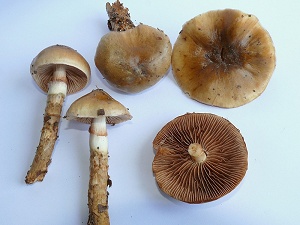| Cortinarius trivialis J.E. Lange |
|
|
|
|
|
|
The cap is clay-brown to orange-red brown, with a central umbo. The cap surface is smooth, viscid or sticky. The stem is white to pale violet, with viscous bracelets (remains of white cortina). The flesh is white, unchanging; its taste is mild; the odour is not distinctive; its texture is fibrous. The gills are white or lilac pale then ochre rusty red, adnate, crowded . The spore print is rusty brown. This species is mycorrhizal. It grows on the ground, in broad-leaved woods, on a rather acid, sometimes calcareous soil, with beech, willow, alder, birch, oak, aspen. The fruiting period takes place from July to November.
Chemical tests : none. Distinctive features : Very slimy cap, red-brown to ochre-brown; stem white at the top, surrounded by viscid interveined brown belts towards the base Cortinarius trivialis is quite rare and scattered in the forest of Rambouillet, and is occasional, more generally speaking . | ||
|
page updated on 14/01/18

